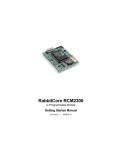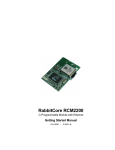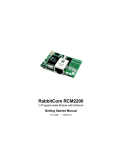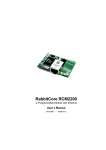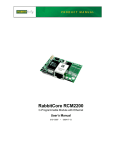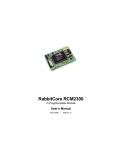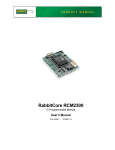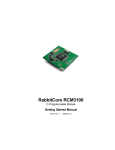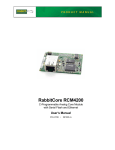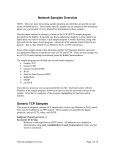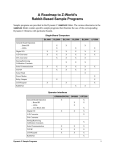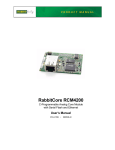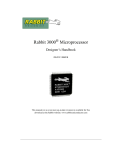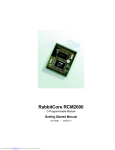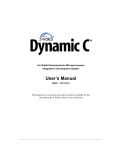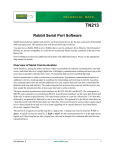Download RabbitCore RCM2200
Transcript
RabbitCore RCM2200 C-Programmable Module with Ethernet Getting Started Manual 019–0096 • 040505–F RabbitCore RCM2200 Getting Started Manual Part Number 019-0096 • 040505–F • Printed in U.S.A. ©2001–2004 Z-World Inc. • All rights reserved. Z-World reserves the right to make changes and improvements to its products without providing notice. Trademarks Rabbit and Rabbit 2000 are registered trademarks of Rabbit Semiconductor. RabbitCore is a trademark of Rabbit Semiconductor. Dynamic C is a registered trademark of Z-World Inc. Z-World, Inc. Rabbit Semiconductor 2900 Spafford Street Davis, California 95616-6800 USA 2932 Spafford Street Davis, California 95616-6800 USA Telephone: (530) 757-3737 Fax: (530) 757-3792 Telephone: (530) 757-8400 Fax: (530) 757-8402 www.zworld.com www.rabbitsemiconductor.com RabbitCore RCM2200 TABLE OF CONTENTS Chapter 1. Introduction & Overview 1 1.1 RCM2200 Description .................................................................................................... 1 1.1.1 Physical & Electrical Specifications ........................................................................................... 2 1.2 Development Software .................................................................................................... 3 1.3 How to Use This Manual ................................................................................................. 3 1.3.1 Additional Product Information .................................................................................................. 3 1.3.2 Additional Reference Information .............................................................................................. 3 1.3.3 Using Online Documentation ...................................................................................................... 4 Chapter 2. Hardware Setup 5 2.1 Development Kit Contents ............................................................................................... 5 2.2 Prototyping Board .......................................................................................................... 6 2.2.1 Prototyping Board Features ......................................................................................................... 7 2.2.2 Prototyping Board Expansion ..................................................................................................... 8 2.3 Development Hardware Connections ................................................................................. 9 2.3.1 Attach Module to Prototyping Board .......................................................................................... 9 2.3.2 Connect Programming Cable .................................................................................................... 10 2.3.3 Connect Ethernet Network Cable .............................................................................................. 11 2.3.4 Connect Power .......................................................................................................................... 12 2.4 Where Do I Go From Here? ........................................................................................... 13 2.4.1 Technical Support ..................................................................................................................... 13 Chapter 3. Software Installation & Overview 15 3.1 An Overview of Dynamic C ........................................................................................... 15 3.1.1 Hardware Requirements ............................................................................................................ 16 3.2 Installing Dynamic C .................................................................................................... 17 3.2.1 Program & Documentation File Location ................................................................................. 17 3.2.2 Installation Type ........................................................................................................................ 18 3.2.3 Select COM Port ....................................................................................................................... 19 3.2.4 Desktop Icons ............................................................................................................................ 19 3.3 Starting Dynamic C ...................................................................................................... 20 3.3.1 Communication Error Messages ............................................................................................... 20 3.4 Sample Programs ......................................................................................................... 21 Getting Started Manual Chapter 4. Using the TCP/IP Features 23 4.1 TCP/IP Connections ......................................................................................................23 4.2 Running TCP/IP Sample Programs ...................................................................................24 4.3 IP Addresses Explained ..................................................................................................26 4.4 How IP Addresses are Used ............................................................................................27 4.5 Dynamically Assigned Internet Addresses .........................................................................28 4.6 Placing Your Device on the Internet .................................................................................29 4.7 How to Set IP Addresses in the Sample Programs................................................................30 4.8 How to Set Up your Computer’s IP Address for Direct Connect .............................................31 4.9 Run the PINGME.C Sample Programs ..............................................................................32 4.10 Running More Sample Programs With Direct Connect .......................................................32 4.11 Where Do I Go From Here? ..........................................................................................33 Notice to Users 35 Index 37 Schematics 39 RabbitCore RCM2200 1. INTRODUCTION & OVERVIEW The RCM2200 is an advanced module that incorporates the powerful Rabbit 2000® microprocessor, flash memory, static RAM, digital I/O ports, and a 10Base-T Ethernet port, all on a PCB just half the size of a business card. 1.1 RCM2200 Description The RCM2200 is a small-footprint module designed for use on a motherboard that supplies power and interface to real-world I/O devices. Its two 26-pin connection headers provide 26 parallel user I/O lines, shared with three serial ports, along with data, address and control lines. A fourth serial port and three additional I/O lines are available on the programming header. A fully-enabled slave port permits glueless master-slave interface with another Rabbitbased system. The slave port may also be used with non-Rabbit systems, although additional logic may be required. The RCM2200 is equipped with a 10Base-T Ethernet port, 256K flash memory and 128K static RAM. There are three production models in the RCM2200 series. If the standard models do not serve your needs, other variations can be specified and ordered in production quantities. Contact your Z-World or Rabbit Semiconductor sales representative for details. Table 1 provides a summary of all the models in the RCM2200 family. Table 1. RCM2200 Versions Feature Microprocessor RCM2200 RCM2210 RCM2250 Rabbit 2000 running at 22.1 MHz Flash Memory 256K 256K 512K Static RAM 128K 128K 512K Yes No Yes RJ-45 Ethernet Connector, Filter Capacitors, and LEDs Serial Ports Getting Started 4, high-speed, CMOS-compatible; 2 configurable as clocked ports; 1 clocked port dedicated to programming port use. 1 In addition, a variant of the RCM2200 is available. The RCM2300 omits the Ethernet connectivity but offers a much smaller footprint, one-half the size of the RCM2200. Another RabbitCore module can be used to reprogram an RCM2200. This reprogramming (and debugging) can be done via the Internet using Z-World’s RabbitLink network programming gateway or with Ethernet-equipped RabbitCore RCM2100 and RCM2200 models using Dynamic C’s DeviceMate features. The RCM2200 is particularly suitable for use as an inexpensive hardware platform for Dynamic C’s DeviceMate features. 1.1.1 Physical & Electrical Specifications Table 2 lists the basic specifications for the RCM2200. Table 2. RCM2200 Specifications Specification Data Power Supply 4.75 – 5.25 V DC (134 mA at 22.1 MHz clock speed) Size 2.3” x 1.6” x 0.86” (59 mm × 41 mm × 22 mm) Environmental –40°C to 70°C, 5–95% humidity, noncondensing NOTE: For complete product specifications, see Appendix A in the RabbitCore RCM2200 User’s Manual. The RCM2200 modules have two 26-pin headers to which cables can be connected, or which can be plugged into matching sockets on a production device. The pinouts for these connectors are shown in Figure 1 below. J4 GND PC0 PC2 TPOUTLNK PD4 /IORD PE0 TPINPE4 ACT A3 A1 J5 VCC PC1 PC3 TPOUT+ PD3 PD5 /IOWR PE1 TPIN+ PE5 PE7 A2 A0 PA0 PA2 PA4 PA6 /RES PB2 PB4 PB7 D6 D4 D2 D0 VCC PA1 PA3 PA5 PA7 PB0 PB3 PB5 D7 D5 D3 D1 VBAT GND Note: These pinouts are as seen on the Bottom Side of the module. Figure 1. RCM2200 Connector Pinout 2 RabbitCore RCM2200 1.2 Development Software The RCM2200 module uses the Dynamic C development environment for rapid creation and debugging of runtime applications. Dynamic C provides a complete development environment with integrated editor, compiler and source-level debugger. It interfaces directly with the target system, eliminating the need for complex and unreliable in-circuit emulators. Dynamic C must be installed on a Windows workstation with at least one free serial (COM) port for communication with the target system. See Chapter 3., “Software Installation & Overview.” for complete information on installing Dynamic C. NOTE: The RCM2200 module requires Dynamic C v7.04 or later for development. A compatible version is included on the Development Kit CD-ROM. 1.3 How to Use This Manual This Getting Started manual is intended to give users a quick but solid start with the RCM2200 module. It does not contain detailed information on the module hardware capabilities, the Dynamic C development environment, or the TCP/IP software support for the integrated Ethernet port. Most users will want more detailed information on some or all of these topics in order to put the RCM2200 module to effective use. 1.3.1 Additional Product Information Detailed information about the RCM2200 will be found in the RabbitCore RCM2200 User’s Manual, provided on the accompanying CD-ROM in both HTML and Adobe PDF format. Some advanced users may choose to skip the rest of this introductory manual and proceed directly with the detailed hardware and software information in the User’s manual. TIP: We recommend that anyone not thoroughly familiar with Z-World controllers at least read through the rest of this manual to gain the necessary familiarity to make use of the more advanced information. 1.3.2 Additional Reference Information In addition to the product-specific information contained in the RabbitCore RCM2200 User’s Manual, several higher-level reference manuals are provided in HTML and PDF form on the accompanying CD-ROM. Advanced users will find these references valuable in developing systems based on the RCM2200 module: • Dynamic C User’s Manual • An Introduction to TCP/IP • Dynamic C TCP/IP User’s Manual • Rabbit 2000 Microprocessor User’s Manual Getting Started 3 1.3.3 Using Online Documentation We provide the bulk of our user and reference documentation in two electronic formats, HTML and Adobe PDF. We do this for several reasons. We believe that providing all users with our complete library of product and reference manuals is a useful convenience. However, printed manuals are expensive to print, stock and ship. Rather than include and charge for manuals that every user may not want, or provide only product-specific manuals, we choose to provide our complete documentation and reference library in electronic form with every development kit and with our Dynamic C development environment. NOTE: The most current version of Adobe Acrobat Reader can always be downloaded from Adobe’s web site at http://www.adobe.com. We recommend that you use version 4.0 or later. Providing this documentation in electronic form saves an enormous amount of paper by not printing copies of manuals that users don’t need. Finding Online Documents The online documentation is installed along with Dynamic C, and an icon for the documentation menu is placed on the workstation’s desktop. Double-click this icon to reach the menu. If the icon is missing, create a new desktop icon that points to default.htm in the docs folder, found in the Dynamic C installation folder. The latest versions of all documents are always available for free, unregistered download from our web sites as well. Printing Electronic Manuals We recognize that many users prefer printed manuals for some uses. Users can easily print all or parts of those manuals provided in electronic form. The following guidelines may be helpful: • Print from the Adobe PDF versions of the files, not the HTML versions. • If your printer supports duplex printing, print pages double-sided. • If you do not have a suitable printer or do not want to print the manual yourself, most retail copy shops (e.g. Kinkos, AlphaGraphics, etc.) will print the manual from the PDF file and bind it for a reasonable charge—about what we would have to charge for a printed and bound manual. 4 RabbitCore RCM2200 2. HARDWARE SETUP This chapter describes the RCM2200 hardware in more detail, and explains how to set up and use the accompanying Prototyping Board. NOTE: This chapter (and this manual) assume that you have the RCM2200 Development Kit. If you purchased an RCM2200 module by itself, you will have to adapt the information in this chapter and elsewhere to your test and development setup. 2.1 Development Kit Contents The RCM2200 Development Kit contains the following items: • RCM2200 module with Ethernet port, 256K flash memory, and 128K SRAM. • RCM2200 Prototyping Board. • Wall transformer power supply, 12 V DC, 500 mA. (Included only with Development Kits sold for the North American market. Overseas users will have to substitute a power supply compatible with local mains power.) • 10-pin header to DE9 programming cable with integrated level-matching circuitry. • Dynamic C CD-ROM, with complete product documentation on disk. • This Getting Started manual. • Rabbit 2000 Processor Easy Reference poster. • Registration card. Getting Started 5 2.2 Prototyping Board The Prototyping Board included in the Development Kit makes it easy to connect an RCM2200 module to a power supply and a PC workstation for development. It also provides some basic I/O peripherals (switches and LEDs), as well as a prototyping area for more advanced hardware development. For the most basic level of evaluation and development, the Prototyping Board can be used without modification. As you progress to more sophisticated experimentation and hardware development, modifications and additions can be made to the board without modifying or damaging the RCM2200 module itself. The Prototyping Board is shown below in Figure 2, with its main features identified. RCM2200/RCM2300 User Reset RCM2200/RCM2300 Slave Module Power Switch Switches Master Module Voltage Connectors Input Connectors Regulator Power User LED LEDs Through-Hole Prototyping Area Master Module Extension Headers Slave Module Extension Headers Battery CAUTION RS-232 Signal Header Battery SMT Prototyping Area Vcc and GND Buses Figure 2. RCM2200/RCM2300 Prototyping Board 6 RabbitCore RCM2200 2.2.1 Prototyping Board Features • Power Connection—A 3-pin header is provided for connection to the power supply. Note that it is symmetrical, with both outer pins connected to ground and the center pin connected to the raw V+ input. The cable of the wall transformer provided with the North American version of the development kit ends in a connector that is correctly connected in either orientation. Users providing their own power supply should ensure that it delivers 8–24 V DC at not less than 500 mA. The voltage regulator will get warm while in use. (Lower supply voltages will reduce thermal dissipation from the device.) • Regulated Power Supply—The raw DC voltage provided at the POWER IN jack is routed to a 5 V linear voltage regulator, which provides stable power to the RCM2200 module and the Prototyping Board. A Shottky diode protects the power supply against damage from reversed raw power connections. • Power LED—The power LED lights whenever power is connected to the Prototyping Board. • Reset Switch—A momentary-contact, normally open switch is connected directly to the RCM2200’s /RES pin. Pressing the switch forces a hardware reset of the system. • I/O Switches and LEDs—Two momentary-contact, normally open switches are connected to the PB2 and PB3 pins of the master RCM2200 module and may be read as inputs by sample applications. Two LEDs are connected to the PE1 and PE7 pins of the master module, and may be driven as output indicators by sample applications. The LEDs and switches are connected through JP1, which has traces shorting adjacent pads together. These traces may be cut to disconnect the LEDs, and an 8-pin header soldered into JP1 to permit their selective reconnection with jumpers. See Figure 3 for details. • Expansion Areas—The Prototyping Board is provided with several unpopulated areas for expansion of I/O and interfacing capabilities. See the next section for details. • Prototyping Area—A generous prototyping area has been provided for the installation of through-hole components. Vcc (5 V DC) and Ground buses run around the edge of this area. An area for surface-mount devices is provided to the right of the through-hole area. (Note that there are SMT device pads on both top and bottom of the Prototyping Board.) Each SMT pad is connected to a hole designed to accept a 30 AWG solid wire. • Slave Module Connectors—A second set of connectors is pre-wired to permit installation of a second, slave RCM2200 or RCM2300 module. This capability is reserved for future use, although the schematics in this manual contain all of the details an experienced developer will need to implement a master-slave system. Getting Started 7 2.2.2 Prototyping Board Expansion The Prototyping Board comes with several unpopulated areas, which may be filled with components to suit the user’s development needs. After you have experimented with the sample programs in Section 3.4, you may wish to expand the board’s capabilities for further experimentation and development. Refer to the Prototyping Board schematic (090– 0122) for details as necessary. • Module Extension Headers—The complete pin sets of both the Master and Slave RabbitCore modules are duplicated at these two sets of headers. Developers can solder wires directly into the appropriate holes, or, for more flexible development, 26-pin header strips can be soldered into place. See Figure 1 for the header pinouts. • RS-232—Two 2-wire or one 4-wire RS-232 serial port can be added to the Prototyping Board by installing a driver IC and four capacitors. The Maxim MAX232CPE driver chip or a similar device is recommended for the U2. Refer to the Prototyping Board schematic for additional details. A 10-pin 0.1-inch spacing header strip can be installed at J6 to permit connection of a ribbon cable leading to a standard DE-9 serial connector. All RS-232 port components mount to the underside of the Prototyping Board, between the Master module connectors. NOTE: The RS-232 chip, capacitors and header strip are available from electronics distributors such as Digi-Key. • Prototyping Board Component Header—Four I/O pins from the module are hardwired to the Prototyping Board LEDs and switches. To disconnect these devices and permit the pins to be used for other purposes, cut the traces between the pin rows of JP1. Use a knife or similar tool to cut or break the traces crossing JP1 in the area between the silk-screened arrows, as indicated in Figure 3. Use jumpers across the positions on JP1 if you need to reconnect any of the devices later on. 8 JP1 DS2 DS3 S2 S3 Cut Cut PE1 PE7 PB2 PB3 Figure 3. Prototyping Board Header JP1 (located on BOTTOM SIDE of board) RabbitCore RCM2200 2.3 Development Hardware Connections There are four steps to connecting the Prototyping Board for use with Dynamic C and the sample programs: 1. Attach the RCM2200 module to the Prototyping Board. 2. Connect the programming cable between the RCM2200 module and the workstation PC. 3. Connect the module’s Ethernet port to a PC’s Ethernet port, or to an Ethernet network. 4. Connect the power supply to the Prototyping Board. 2.3.1 Attach Module to Prototyping Board EGND ACT DS2 JP5 C1 RCM2200 LNK JP1 C30 JP2 U8 U7 JP6 C7 GND C29 GND Turn the RCM2200 module so that the Ethernet connector end of the module extends off the Prototyping Board, as shown in Figure 4 below. Align the module headers J4 and J5 into sockets J1 and J2 on the Prototyping Board. Y2 C2 U3 DS1 R18 Y3 R16 R19 Q4 Q3 C13 R20 C12 R17 Q2 R15 U1 BT1 C8 R9 R11 R13 Q5 R21 R22 R37 Y1 C4 R1 C17 R2 J1 C14 C25 R8 R36 D2 R7 U6 C3 U2 R38 C27 C28 RT1 D3 D1 R41 J2 JP3 JP4 R39 Battery CAUTION Line up the mounting holes Figure 4. Installing the RCM2200 on the Prototyping Board Getting Started 9 Although you can install a single module into either the MASTER or the SLAVE position on the Prototyping Board, all the Prototyping Board features (switches, LEDs, serial port drivers, etc.) are connected to the MASTER position. We recommend you install a single module in the MASTER position. NOTE: It is important that you line up the pins on headers J4 and J5 of the RCM2200 exactly with the corresponding pins of headers J1 and J2 on the Prototyping Board. The header pins may become bent or damaged if the pin alignment is offset, and the module will not work. Permanent electrical damage to the module may also result if a misaligned module is powered up. Press the module’s pins firmly into the Prototyping Board headers. 2.3.2 Connect Programming Cable The programming cable connects the RCM2200 module to the PC running Dynamic C to download programs and to monitor the RCM2200 for debugging. Connect the 10-pin connector of the programming cable labeled PROG to header J1 on the RCM2200 module as shown in Figure 5. Be sure to orient the marked (usually red) edge of the cable towards pin 1 of the connector. (Do not use the DIAG connector, which is used for a normal serial connection.) Connect the other end of the programming cable to a COM port on your PC. Make a note of the port to which you connect the cable, as Dynamic C needs to have this parameter configured when it is installed. Figure 5. Connect Programming Cable to RCM2200 NOTE: COM 1 is the default port used by Dynamic C. 10 RabbitCore RCM2200 2.3.3 Connect Ethernet Network Cable Programming and development can be done with the RCM2200 without connecting the Ethernet port to a network. However, if you will be running the sample programs that use the Ethernet capability or will be doing Ethernet-enabled development, you should connect the RCM2200 module’s Ethernet port at this time. There are four options for connecting the RCM2200 to a network for development and runtime purposes. The first two options permit total freedom of action in selecting network addresses and use of the “network,” as no action can interfere with other users. We recommend one of these options for initial development. • No LAN — The simplest alternative for desktop development. Connect the RCM2200’s Ethernet port directly to the PC’s network interface card using an RJ-45 crossover cable. A crossover cable is a special cable that flips some connections between the two connectors and permits direct connection of two client systems. A standard RJ-45 network cable will not work for this purpose. • Micro-LAN — Another simple alternative for desktop development. Use a small Ethernet 10Base-T hub and connect both the PC’s network interface card and the RCM2200’s Ethernet port to it, using standard network cables. The following options require more care in address selection and testing actions, as conflicts with other users, servers and systems can occur: • LAN — Connect the RCM2200’s Ethernet port to an existing LAN, preferably one to which the development PC is already connected. You will need to obtain IP addressing information from your network administrator. • WAN — The RCM2200 is capable of direct connection to the Internet and other Wide Area Networks, but exceptional care should be used with IP address settings and all network-related programming and development. We recommend that development and debugging be done on a local network before connecting a RabbitCore system to the Internet. TIP: Checking and debugging the initial setup on a micro-LAN is recommended before connecting the system to a LAN or WAN. Getting Started 11 2.3.4 Connect Power When all other connections have been made, you can connect power to the RCM2200 Prototyping Board. Hook the connector from the wall transformer to header J5 on the Prototyping Board as shown in Figure 6 below. The connector may be attached either way as long as it is not offset to one side. AC Adapter C1 EGND ACT DS2 JP5 LNK JP1 C30 JP2 U8 U7 JP6 C7 GND C29 GND RCM2200 Y2 C2 U3 DS1 R18 R16 Y3 Q4 Q3 C13 R20 R19 Q2 C12 R17 R15 U1 BT1 C8 R9 R11 R13 Q5 R21 R22 R37 Y1 C4 R1 C17 R2 J1 PROG C14 C25 R8 R36 D2 R7 U6 C3 U2 R38 C27 C28 D3 RT1 D1 R39 J2 JP3 JP4 R41 Prototyping Reset Board Switch DIAG Figure 6. Power Supply Connections Plug in the wall transformer. The power LED on the Prototyping Board should light up. The RCM2200 and the Prototyping Board are now ready to be used. NOTE: A RESET button is provided on the Prototyping Board to allow hardware reset without disconnecting power. To power down the Prototyping Board, unplug the power connector from J5. You should disconnect power before making any circuit adjustments in the prototyping area, changing any connections to the board, or removing the RabbitCore module from the board. 12 RabbitCore RCM2200 2.4 Where Do I Go From Here? We recommend that you proceed to the next chapter and install Dynamic C (if you do not already have it installed), then run the first sample program to verify that the RCM2200 module and the Prototyping Board are set up and functioning correctly. If everything appears to be working, we recommend the following sequence of action: 1. Run all of the sample programs described in Section 3.4 to get a basic familiarity with Dynamic C and the RCM2200 module’s capabilities. 2. For further development, refer to the RabbitCore RCM2200 User’s Manual for details of the module’s hardware and software components. A documentation icon should have been installed on your workstation’s desktop; click on it to reach the documentation menu. You can create a new desktop icon that points to default.htm in the docs folder in the Dynamic C installation folder. 3. For advanced development topics, refer to the Dynamic C User’s Manual and the Dynamic C TCP/IP User’s Manual, also in the online documentation set. 2.4.1 Technical Support NOTE: If you purchased your RCM2200 through a distributor or through a Z-World or Rabbit Semiconductor partner, contact the distributor or Z-World partner first for technical support. If there are any problems at this point: • Check the Z-World/Rabbit Semiconductor Technical Bulletin Board at www.zworld.com/support/bb/. • Use the Technical Support e-mail form at www.zworld.com/support/support_submit.html. Getting Started 13 14 RabbitCore RCM2200 3. SOFTWARE INSTALLATION & OVERVIEW To develop and debug programs for the RCM2200 (and for all other Z-World and Rabbit Semiconductor hardware), you must install and use Dynamic C. This chapter takes you through the installation of Dynamic C, and then provides a tour of its major features with respect to the RCM2200 module. 3.1 An Overview of Dynamic C Dynamic C integrates the following development functions into one program: • Editing • Compiling • Linking • Loading • In-Circuit Debugging In fact, compiling, linking and loading are one function. Dynamic C does not use an InCircuit Emulator; programs being developed are downloaded to and executed from the “target” system via an enhanced serial-port connection. Program development and debugging take place seamlessly across this connection, greatly speeding system development. Other features of Dynamic C include: • Dynamic C has an easy-to-use built-in text editor. Programs can be executed and debugged interactively at the source-code or machine-code level. Pull-down menus and keyboard shortcuts for most commands make Dynamic C easy to use. • Dynamic C also supports assembly language programming. It is not necessary to leave C or the development system to write assembly language code. C and assembly language may be mixed together. • Debugging under Dynamic C includes the ability to use printf commands, watch expressions, breakpoints and other advanced debugging features. Watch expressions can be used to compute C expressions involving the target’s program variables or functions. Watch expressions can be evaluated while stopped at a breakpoint or while the target is running its program. Getting Started 15 • Dynamic C provides extensions to the C language (such as shared and protected variables, costatements and cofunctions) that support real-world embedded system development. Interrupt service routines may be written in C. Dynamic C supports cooperative and preemptive multi-tasking. • Dynamic C comes with many function libraries, all in source code. These libraries support real-time programming, machine level I/O, and provide standard string and math functions. • Dynamic C compiles directly to memory. Functions and libraries are compiled and linked and downloaded on-the-fly. On a fast PC, Dynamic C can load 30,000 bytes of code in 5 seconds at a baud rate of 115,200 bps. 3.1 Hardware Requirements To install and run Dynamic C, your system must be running one of the following operating systems: • Windows 95 • Windows 98 • Windows NT • Windows Me • Windows 2000 3.1.1 Hardware Requirements The PC on which you install Dynamic C for development of RCM2200-based systems should have the following hardware: • A Pentium or later microprocessor • 32 MB of RAM • At least 50 MB of free hard drive space • At least one free COM (serial) port for communication with the target systems • A 10Base-T Ethernet network interface port (optional if you will not be using the RCM2200’s Ethernet port) • A CD-ROM drive (for software installation) 16 RabbitCore RCM2200 3.2 Installing Dynamic C Insert the Dynamic C CD-ROM in the drive on your PC. If autorun is enabled, the CD installation will begin automatically. If autorun is disabled or the installation otherwise does not start, use the Windows Start | Run menu or Windows Disk Explorer to launch SETUP.EXE from the root folder of the CD-ROM. The installation program will guide you through the installation process. Most steps of the process are self-explanatory and not covered in this section. Selected steps that may be confusing to some users are outlined below. (Some of the installation utility screens may vary slightly from those shown.) 3.2.1 Program & Documentation File Location Dynamic C’s application, library and documentation files can be installed in any convenient location on your workstation’s hard drives. The default location, as shown in the example above, is in a folder named for the version of Dynamic C, placed in the root folder of the C: drive. If this location is not suitable, enter a different root path before clicking Next >. Files are placed in the specified folder, so do not set this location to a drive’s root directory. Getting Started 17 3.2.2 Installation Type Dynamic C has two components that can be installed together or separately. One component is Dynamic C itself, with the development environment, support files and libraries. The other component is the documentation library in HTML and PDF formats, which may be left uninstalled to save hard drive space or installed elsewhere (on a separate or network drive, for example). The installation type is selected in the installation menu shown above. The options are: • Typical Installation — Both Dynamic C and the documentation library will be installed in the specified folder (default). • Compact Installation — Only Dynamic C will be installed. • Custom Installation — You will be allowed to choose which components are installed. This choice is useful to install or reinstall just the documentation. 18 RabbitCore RCM2200 3.2.3 Select COM Port Dynamic C uses a COM (serial) port to communicate with the target development system. The installation allows you to choose the COM port that will be used. The default selection, as shown in the example above, is COM1. You may select any available port for Dynamic C’s use. If you are not certain which port is available, select COM1. This selection can be changed later within Dynamic C. NOTE: The installation utility does not check the selected COM port in any way. Specifying a port in use by another device (mouse, modem, etc.) may cause temporary problems when Dynamic C is started. 3.2.4 Desktop Icons Once your installation is complete, you will have up to three icons on your PC desktop, as shown below. One icon is for Dynamic C, one opens the documentation menu, and the third is for the Rabbit Field Utility, a tool used to download precompiled software to a target system. Getting Started 19 3.3 Starting Dynamic C Once the RCM2200 module is set up and connected as described in Chapter 2 and Dynamic C has been installed, start Dynamic C by double-clicking on the Dynamic C icon. Dynamic C should start, then look for the target system on the COM port you specified during installation (by default, COM1). Once detected, Dynamic C should go through a sequence of steps to cold-boot the module and compile the BIOS. If you receive the message beginning "BIOS successfully compiled and loaded", you are ready to continue with the sample programs. 3.3.1 Communication Error Messages If you receive the message "No Rabbit Processor Detected", the programming cable may be connected to a different COM port, a connection may be faulty, or the target system may not be powered up. First, check to see that the power LED on the prototyping board is lit. If it is, check both ends of the programming cable to ensure that it is firmly plugged into the PC and the RCM2200’s programming port. If you are using the Prototyping Board, ensure that the module is firmly and correctly installed in its connectors. If there are no faults with the hardware, select a different COM port within Dynamic C. From the Options menu, select Project Options, then select Communications. The dialog shown should appear. Select another COM port from the list, then click OK. Press <Ctrl-Y> to force Dynamic C to recompile the BIOS. If Dynamic C still reports it is unable to locate the target system, repeat the above steps until you locate the active COM port. If Dynamic C appears to compile the BIOS successfully, but you then receive a communication error message, it is possible that your PC cannot handle the 115,200 bps baud rate. Try changing the baud rate to 57,600 bps as follows. • Locate the Serial Options dialog in the Dynamic C Options > Project Options > Communications menu. Change the baud rate to 57,600 bps. 20 RabbitCore RCM2200 3.4 Sample Programs To help familiarize you with the RCM2200 modules, Dynamic C includes several sample programs. Loading, executing and studying these programs will give you a solid hands-on overview of the RabbitCore’s capabilities, as well as a quick start with Dynamic C as an application development tool. NOTE: The sample programs assume that you have at least an elementary grasp of ANSI C. If you do not, see the introductory pages of the Dynamic C User’s Manual for a suggested reading list. Of the many sample programs included with Dynamic C, several are specific to the RCM2200 module. These programs will be found in the Samples\RCM2200 folder. We suggest that you examine the following five of these sample programs in order to get a complete tour of the capabilities of the RCM2200 modules. They form a “learning arc” from basic I/O control to advanced TCP/IP issues, including Web serving: • FlashLED.c • ToggleLED.c • FlashLEDs.c • EXTSRAM.c • PUTS.c • MASTER.c • SLAVE.C Each of these programs is fully commented within the source code. Refer to these comments for the details of how each program works. TCP/IP sample programs are discussed in Chapter 4, “Using the TCP/IP Features.” Once you have loaded and executed these five programs and have an understanding of how Dynamic C and the RCM2200 modules interact, you can move on and try the other sample programs, or begin building your own. Getting Started 21 22 RabbitCore RCM2200 4. USING THE TCP/IP FEATURES 4.1 TCP/IP Connections Before proceeding you will need to have the following items. • If you don’t have Ethernet access, you will need at least a 10Base-T Ethernet card (available from your favorite computer supplier) installed in a PC. • Two RJ-45 straight through Ethernet cables and a hub, or an RJ-45 crossover Ethernet cable. The Ethernet cables and Ethernet hub are available from Z-World in a TCP/IP tool kit. More information is available at www.zworld.com. 1. Connect the AC adapter and the programming cable as shown in Chapter 2, “Hardware Setup,” 2. Ethernet Connections If you do not have access to an Ethernet network, use a crossover Ethernet cable to connect the RCM2200 board to a PC with at least a 10Base-T Ethernet card. If you have Ethernet access, use a straight Ethernet cable to establish an Ethernet connection to the RCM2200 from an Ethernet hub. The PC running Dynamic C through the serial port on the RCM2200 does not need to be the PC with the Ethernet card. 3. Apply Power Plug in the AC adapter. The RCM2200 is now ready to be used. Getting Started 23 4.2 Running TCP/IP Sample Programs We have provided a number of sample programs demonstrating various uses of TCP/IP for networking embedded systems. These programs require that the user connect his PC and the RCM2200 board together on the same network. This network can be a local private network (preferred for initial experimentation and debugging), or a connection via the Internet. RCM2200 Board User’s PC Ethernet crossover cable Direct Connection (Network of 2 computers) RCM2200 Board Ethernet cables To additional network Hub elements Direct Connection Using a Hub Obtaining IP addresses to interact over an existing, operating, network can involve a number of complications, and must usually be done with cooperation from your ISP and/or network systems administrator (if your company has one). For this reason, it is suggested that the user begin instead by using a direct connection between a PC and the RCM2200 board using an Ethernet crossover cable or a simple arrangement with a hub. (A crossover cable should not be confused with regular straight through cables.) The hub and a wide variety of cables can also be purchased from a local computer store. In order to set up this direct connection, the user will have to use a PC without networking, or disconnect a PC from the corporate network, or install a second Ethernet adapter and set up a separate private network attached to the second Ethernet adapter. Disconnecting your PC from the corporate network may be easy or nearly impossible, depending on how it is set up. Mobile PCs, such as laptops, are designed to be connected and disconnected, and will present the least problem. If your PC boots from the network or is dependent on the network for some or all of its disks, then it probably should not be disconnected. If a second Ethernet adapter is used, be aware that Windows TCP/IP will send messages to one adapter or the other, depending on the IP address and the binding order in Microsoft products. Thus you should have different ranges of IP addresses on your private network from those used on the corporate network. If both networks service the same IP address, then Windows may send a packet intended for your private network to the corporate network. A similar situation will take place if you use a dial-up line to send a packet to the Internet. Windows may try to send it via the local Ethernet network if it is also valid for that network. 24 RabbitCore RCM2200 The following IP addresses are set aside for local networks and are not allowed on the Internet: 10.0.0.0 to 10.255.255.255, 172.16.0.0 to 172.31.255.255, and 192.168.0.0 to 192.168.255.255. The RCM2200 board uses a 10Base-T type of Ethernet connection, which is the most common scheme. The RJ-45 connectors are similar to U.S. style telephone connectors, are except larger and have 8 contacts. An alternative to the direct connection using a crossover cable is a direct connection using a hub. The hub relays packets received on any port to all of the ports on the hub. Hubs are low in cost and are readily available. The RCM2200 board uses 10 Mbps Ethernet, so the hub or Ethernet adapter must be either a 10 Mbps unit or a 10/100 unit that adapts to either 10 or 100 Mbps. In a corporate setting where the Internet is brought in via a high-speed line, there are typically machines between the outside Internet and the internal network. These machines include a combination of proxy servers and firewalls that filter and multiplex Internet traffic. In the configuration below, the RCM2200 board could be given a fixed address so any of the computers on the local network would be able to contact it. It may be possible to configure the firewall or proxy server to allow hosts on the Internet to directly contact the controller, but it would probably be easier to place the controller directly on the external network outside of the firewall. This avoids some of the configuration complications by sacrificing some security. Hub(s) T1 in Adapter Ethernet Firewall Proxy Server Network Ethernet Typical Corporate Network RCM2200 Board If your system administrator can give you an Ethernet cable along with its IP address, the netmask and the gateway address, then you may be able to run the sample programs without having to setup a direct connection between your computer and the RCM2200 board. You will also need the IP address of the nameserver, the name or IP address of your mail server, and your domain name for some of the sample programs. Getting Started 25 4.3 IP Addresses Explained IP (Internet Protocol) addresses are expressed as 4 decimal numbers separated by periods, for example: 216.103.126.155 10.1.1.6 Each decimal number must be between 0 and 255. The total IP address is a 32-bit number consisting of the 4 bytes expressed as shown above. A local network uses a group of adjacent IP addresses. There are always 2N IP addresses in a local network. The netmask (also called subnet mask) determines how many IP addresses belong to the local network. The netmask is also a 32-bit address expressed in the same form as the IP address. An example netmask is: 255.255.255.0 This netmask has 8 zero bits in the least significant portion, and this means that 28 addresses are a part of the local network. Applied to the IP address above (216.103.126.155), this netmask would indicate that the following IP addresses belong to the local network: 216.103.126.0 216.103.126.1 216.103.126.2 etc. 216.103.126.254 216.103.126.255 The lowest and highest address are reserved for special purposes. The lowest address (216.102.126.0) is used to identify the local network. The highest address (216.102.126.255) is used as a broadcast address. Usually one other address is used for the address of the gateway out of the network. This leaves 256 - 3 = 253 available IP addresses for the example given. 26 RabbitCore RCM2200 4.4 How IP Addresses are Used The actual hardware connection via an Ethernet uses Ethernet adapter addresses (also called MAC addresses.) These are 48-bit addresses and are unique for every Ethernet adapter manufactured. In order to send a packet to another computer, given the IP address of the other computer, it is first determined if the packet needs to be sent directly to the other computer or to the gateway. In either case, there is an IP address on the local network to which the packet must be sent. A table is maintained to allow the protocol driver to determine the MAC address corresponding to a particular IP address. If the table is empty, the MAC address is determined by sending an Ethernet broadcast packet to all devices on the local network asking the device with the desired IP address to answer with its MAC address. In this way, the table entry can be filled in. If no device answers, then the device is nonexistent or inoperative, and the packet cannot be sent. IP addresses are arbitrary and can be allocated as desired provided that they don’t conflict with other IP addresses. However, if they are to be used with the Internet, then they must be numbers that are assigned to your connection by proper authorities, generally by delegation via your service provider. Getting Started 27 4.5 Dynamically Assigned Internet Addresses In many instances, there are no fixed IP addresses. This is the case when, for example, you are assigned an IP address dynamically by your dial-up Internet service provider (ISP) or when you have a device that provides your IP addresses using the Dynamic Host Configuration Protocol (DHCP). The RCM2200 can use such IP addresses to send and receive packets on the Internet, but you must take into account that this IP address may only be valid for the duration of the call or for a period of time, and could be a private IP address that is not directly accessible to others on the Internet. These private address can be used to perform some Internet tasks such as sending e-mail or browsing the Web, but usually cannot be used to participate in conversations that originate elsewhere on the Internet. If you want to find out this dynamically assigned IP address, under Windows 98 you can run the winipcfg program while you are connected and look at the interface used to connect to the Internet. Many networks use private IP addresses that are assigned using DHCP. When your computer comes up, and periodically after that, it requests its networking information from a DHCP server. The DHCP server may try to give you the same address each time, but a fixed IP address is usually not guaranteed. If you are not concerned about accessing the RCM2200 from the Internet, you can place the RCM2200 on the internal network using a private address assigned either statically or through DHCP. 28 RabbitCore RCM2200 4.6 Placing Your Device on the Internet In many corporate settings, users are isolated from the Internet by a firewall and/or a proxy server. These devices attempt to secure the company from unauthorized network traffic, and usually work by disallowing traffic that did not originate from inside the network. If you want users on the Internet to communicate with your RCM2200, you have several options. You can either place the RCM2200 directly on the Internet with a real Internet address or place it behind the firewall. If you place the RCM2200 behind the firewall, you need to configure the firewall to translate and forward packets from the Internet to the RCM2200. Getting Started 29 4.7 How to Set IP Addresses in the Sample Programs We have provided a number of sample programs demonstrating various uses of TCP/IP for networking embedded systems. These programs require that you connect your PC and the Coyote together on the same network. This network can be a local private network (preferred for initial experimentation and debugging), or a connection via the Internet. With the introduction of Dynamic C 7.30 we have taken steps to make it easier to run many of our sample programs. You will see a TCPCONFIG macro. This macro tells Dynamic C to select your configuration from a list of default configurations. You will have three choices when you encounter a sample program with the TCPCONFIG macro. 1. You can replace the TCPCONFIG macro with individual MY_IP_ADDRESS, MY_NETMASK, MY_GATEWAY, and MY_NAMESERVER macros in each program. 2. You can leave TCPCONFIG at the usual default of 1, which will set the IP configurations to 10.10.6.100, the netmask to 255.255.255.0, and the nameserver and gateway to 10.10.6.1. If you would like to change the default values, for example, to use an IP address of 10.1.1.2 for the Coyote board, and 10.1.1.1 for your PC, you can edit the values in the section that directly follows the “General Configuration” comment in the TCP_CONFIG.LIB library. You will find this library in the LIB\TCPIP directory. 3. You can create a CUSTOM_CONFIG.LIB library and use a TCPCONFIG value greater than 100. Instructions for doing this are at the beginning of the TCP_CONFIG.LIB library in the LIB\TCPIP directory. There are some other “standard” configurations for TCPCONFIG that let you select different features such as DHCP. Their values are documented at the top of the TCP_CONFIG.LIB library in the LIB\TCPIP directory. More information is available in the Dynamic C TCP/IP User’s Manual. IP Addresses Before Dynamic C 7.30 Most of the sample programs use macros to define the IP address assigned to the board and the IP address of the gateway, if there is a gateway. Instead of the TCPCONFIG macro, you will see a MY_IP_ADDRESS macro and other macros. #define #define #define #define MY_IP_ADDRESS "10.10.6.170" MY_NETMASK "255.255.255.0" MY_GATEWAY "10.10.6.1" MY_NAMESERVER "10.10.6.1" In order to do a direct connection, the following IP addresses can be used for the Coyote: #define MY_IP_ADDRESS "10.1.1.2" #define MY_NETMASK "255.255.255.0" // #define MY_GATEWAY "10.10.6.1" // #define MY_NAMESERVER "10.10.6.1" In this case, the gateway and nameserver are not used, and are commented out. The IP address of the board is defined to be 10.1.1.2. The IP address of your PC can be defined as 10.1.1.1. 30 RabbitCore RCM2200 4.8 How to Set Up your Computer’s IP Address for Direct Connect When your computer is connected directly to the RCM2200 board via an Ethernet connection, you need to assign an IP address to your computer. To assign the PC the address 10.10.6.101 with the netmask 255.255.255.0, do the following. Click on Start > Settings > Control Panel to bring up the Control Panel, and then double-click the Network icon. Depending on which version of Windows you are using, look for the TCP/IP Protocol/Network > Dial-Up Connections/Network line or tab. Doubleclick on this line or select Properties or Local Area Connection > Properties to bring up the TCP/IP properties dialog box. You can edit the IP address and the subnet mask directly. (Disable “obtain an IP address automatically.”) You may want to write down the existing values in case you have to restore them later. It is not necessary to edit the gateway address since the gateway is not used with direct connect. RCM2200 Board IP 10.10.6.101 Netmask 255.255.255.0 User’s PC Ethernet crossover cable Direct Connection PC to RCM2200 Board Getting Started 31 4.9 Run the PINGME.C Sample Programs Connect the crossover cable from your computer’s Ethernet port to the RCM2200 board’s RJ-45 Ethernet connector. Open this sample program from the SAMPLES\TCPIP\ICMP folder, compile the program, and start it running under Dynamic C. When the program starts running, the green LNK light on the RCM2200 board should be on to indicate an Ethernet connection is made. (Note: If the LNK light does not light, you may not have a crossover cable, or if you are using a hub perhaps the power is off on the hub.) The next step is to ping the board from your PC. This can be done by bringing up the MSDOS window and running the pingme program: ping 10.10.6.100 or by Start > Run and typing the entry ping 10.10.6.100 Notice that the red ACT light flashes on the RCM2200 board while the ping is taking place, and indicates the transfer of data. The ping routine will ping the board four times and write a summary message on the screen describing the operation. 4.10 Running More Sample Programs With Direct Connect The sample programs discussed here are in the Dynamic C SAMPLES\RCM2200\ folder. • CONSOLE.C—Demonstrates the features of ZCONSOLE.LIB command-oriented console library. This program is also run in conjunction with SERDCLIENT.C or SPCLIENT.C. • ETHCORE1.C—Creates two “devices” (lights) and two “buttons” in the Web browser to toggle them. Users can change the status of the lights. If the RCM2200 is plugged into the MASTER slot on the Prototyping Board, the lights on the Prototyping Board will track the ones in the Web browser. As long as you have not modified the TCPCONFIG 1 macro in the sample program, enter the following server address in your Web browser to bring up the Web page served by the sample program. http://10.10.6.100 Otherwise use the TCP/IP settings you entered in the TCP_CONFIG.LIB library. • MYECHO.C—Operates RCM2200 as a basic server. When a client connects, echoes back any data sent by the client. • SERDCLIENT.C—Demonstrates the ability of a Rabbit-based target board to update files on the Web server of the RCM2200 board it is connected to via Serial Port D. This program is run in conjunction with CONSOLE.C. • SPCLIENT.C—Demonstrates the ability of a Rabbit-based target board to update files on the Web server of the RCM2200 board it is connected to via the slave port. This program is run in conjunction with CONSOLE.C. 32 RabbitCore RCM2200 4.11 Where Do I Go From Here? NOTE: If you purchased your RCM2200 through a distributor or through a Z-World or Rabbit Semiconductor partner, contact the distributor or Z-World partner first for technical support. If there are any problems at this point: • Check the Z-World/Rabbit Semiconductor Technical Bulletin Board at www.zworld.com/support/bb/. • Use the Technical Support e-mail form at www.zworld.com/support/support_submit.html. If the sample programs ran fine, you are now ready to go on. Additional sample programs are described in the Dynamic C TCP/IP User’s Manual. Please refer to the Dynamic C TCP/IP User’s Manual to develop your own applications. An Introduction to TCP/IP provides background information on TCP/IP, and is available on the CD and on Z-World’s Web site. Getting Started 33 34 RabbitCore RCM2200 NOTICE TO USERS Z-WORLD PRODUCTS ARE NOT AUTHORIZED FOR USE AS CRITICAL COMPONENTS IN LIFESUPPORT DEVICES OR SYSTEMS UNLESS A SPECIFIC WRITTEN AGREEMENT REGARDING SUCH INTENDED USE IS ENTERED INTO BETWEEN THE CUSTOMER AND Z-WORLD PRIOR TO USE. Life-support devices or systems are devices or systems intended for surgical implantation into the body or to sustain life, and whose failure to perform, when properly used in accordance with instructions for use provided in the labeling and user’s manual, can be reasonably expected to result in significant injury. No complex software or hardware system is perfect. Bugs are always present in a system of any size. In order to prevent danger to life or property, it is the responsibility of the system designer to incorporate redundant protective mechanisms appropriate to the risk involved. All Z-World products are 100 percent functionally tested. Additional testing may include visual quality control inspections or mechanical defects analyzer inspections. Specifications are based on characterization of tested sample units rather than testing over temperature and voltage of each unit. Z-World products may qualify components to operate within a range of parameters that is different from the manufacturer’s recommended range. This strategy is believed to be more economical and effective. Additional testing or burn-in of an individual unit is available by special arrangement. Getting Started 35 36 RabbitCore RCM2200 INDEX A F R additional information online documentation .......... 4 references ............................ 3 features Prototyping Board ........... 6, 7 RCM2200 ............................ 1 C H C language ...................... 15, 16 hardware connections ............. 9 Ethernet ............................. 11 install RCM2200 on Prototyping Board ........................ 9 power supply ..................... 12 programming cable ........... 10 hardware reset ....................... 12 RCM2200 mounting on Prototyping Board .............................. 9 reset ....................................... 12 running TCP/IP sample programs ............................ 24 D Development Kit ..................... 5 Dynamic C .................. 3, 15, 16 assembly language ............ 15 debugger ............................ 15 debugging .......................... 15 desktop icons ..................... 19 editor ................................. 15 features .............................. 15 handling communication error messages ....................... 20 hardware requirements ...... 16 installing ................ 17, 18, 19 interrupt service routines .. 16 sample programs ............... 21 starting .............................. 20 watch expressions ............. 15 E Ethernet cables ................ 11, 23 Ethernet connections . 11, 23, 25 10Base-T ........................... 25 10Base-T Ethernet card .... 23 additional resources .......... 33 Ethernet cables .................. 25 Ethernet hub ...................... 23 IP addresses ................. 24, 26 steps .................................. 23 Getting Started I IP addresses .................... 26, 31 how to set .......................... 30 how to set PC IP address ... 31 J JP1 Prototyping Board ............... 8 M models factory versions ................... 1 P pinout RCM2200 ............................ 2 power supply connections ....................... 12 programming cable RCM2200 connections ..... 10 Prototyping Board ................... 6 expansion area ..................... 8 features ............................ 6, 7 mounting RCM2200 ........... 9 optional header JP1 ............. 8 S sample programs ................... 21 EXTSRAM.C .................... 21 FLASHLED.C .................. 21 FLASHLEDS.C ................ 21 how to set IP address ........ 30 MASTER.C ...................... 21 PUTS.C ............................. 21 SLAVE.C .......................... 21 TCP/IP .............................. 24 CONSOLE.C ................ 32 ETHCORE1.C .............. 32 MYECHO.C .................. 32 PINGME.C .................... 32 running TCP/IP sample programs .......................... 24 SERDCLIENT.C .......... 32 SPCLIENT.C ................ 32 TOGGLELED.C ............... 21 software sample programs ............... 21 specifications physical and electrical ......... 2 T technical support ................... 13 37 38 RabbitCore RCM2200 SCHEMATICS 090-0120 RCM2200 Schematic www.rabbitsemiconductor.com/documentation/schemat/090-0120.pdf 090-0122 RCM2200 Prototyping Board Schematic www.rabbitsemiconductor.com/documentation/schemat/090-0122.pdf 090-0128 Programming Cable Schematic www.rabbitsemiconductor.com/documentation/schemat/090-0128.pdf The schematics included with the printed manual were the latest revisions available at the time the manual was last revised. The online versions of the manual contain links to the latest revised schematic on the Web site. You may also use the URL information provided above to access the latest schematics directly. Getting Started 39












































